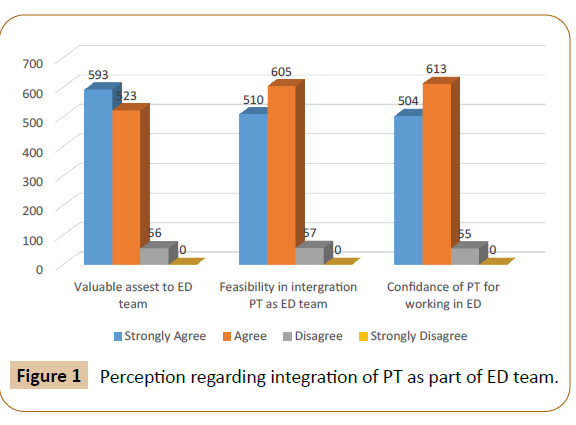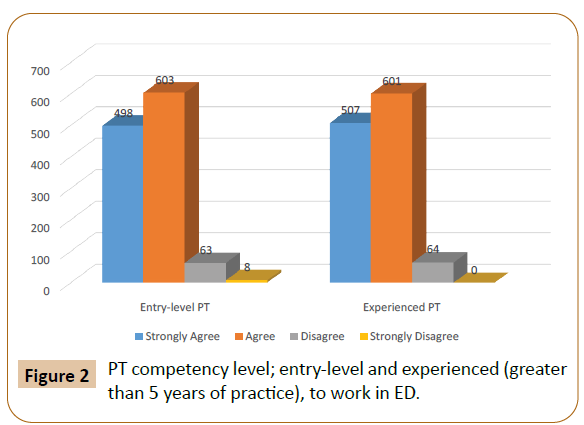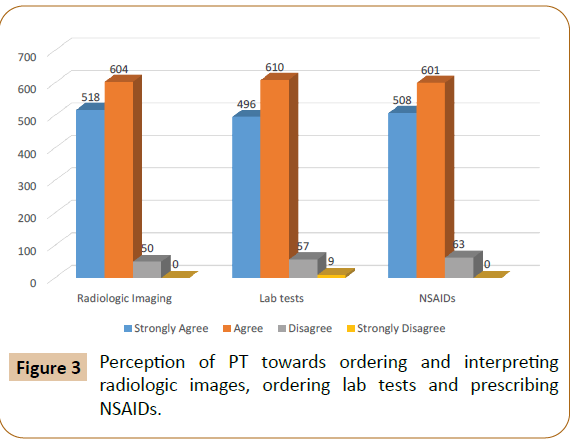Perception of Physical Therapist Regarding the Role of Physical Therapy in Emergency Department
1Department of Sports Medicine and Manipulative Physical Therapy, Senior Lecturer at Isra University Hyderabad, Pakistan
2Consultant Physical Therapist, Assistant Professor at Isra University Hyderabad, Pakistan
- *Corresponding Author:
- Dr. Muhammad Zubair Khan
Consultant Physical Therapist
Assistant Professor at Isra University Hyderabad
Pakistan
Tel: + 0336-1219149
E-mail: mzk_physio@hotmail.com
Received Date: May 29, 2021; Accepted Date: September 29, 2021; Published Date: October 25, 2021
Citation: Kanwal L, Shamsa, Muhammad
ZK, Muhammad HN (2021) Perception of
Physical Therapist Regarding the Role of
Physical Therapy in Emergency Department.
J Physiother Res Vol.5 No.10:46
Abstract
Background: The physical therapy profession is expanding day by day. They can practice as a primary contact healthcare provider, independently diagnosing and treating several conditions and disorders through comprehensive knowledge and expertise. Their role is also emerging in the emergency department setting but only hand full of physical therapist are found currently in emergency department.
Objective: The motive of this study is to determine the perception of physical therapist regarding the role of physical therapy in emergency department.
Method: It is a cross sectional study in which physical therapist of various hospitals of Hyderabad, Karachi and Nawabshah were distributed questionnaire extracted from research of Marla J. Weisend et al on “physical therapists’ perception of physiotherapy in emergency department” in 2011. Sampling was convenient. The analysis of data was carried out by using statistical package for social sciences (SPSS) version 21.
Results: 1172 subjects completed and returned questionnaires. Majority (1116 participants) believed that physical therapist was an invaluable strength to emergency department and 1115 participants believed that merging physical therapist in emergency department is feasible. 1117 participants were confident in assessing and treating patients in emergency department. Factors including commanding radiological imaging (1122 participants), instructing lab test (1106 participants) and advising NSAIDs (1109 participants) also represent the positive perception of physical therapist about their role in emergency department.
Conclusion: Positive perception is present among physical therapist regarding their role in emergency department but majority of them have not assessed or treated patient in emergency department.
Concept of Emergency Department
Historically the emergency department is defined as “the dedicated area in a public hospital that is organized and administered to provide emergency care to those in the community who perceive the need for or are in the need of acute or urgent care.” [1-9] The basic care is provided in emergency department, 24 hours a day, without any circumscription to the number of people presenting to emergency department and it is authorized and a moral responsibility to envision every patient [10]. For many individuals, emergency department draw the image of life-ordeath situations, in which the patient reaches the hospital in ambulance, rushed on stretcher for an urgent treatment for an extensive trauma [11]. In reality, most of the patients presented in emergency department are of minor conditions or lesser urgency. (11)
Background of Emergency Department Physiotherapy
Emergency department physiotherapy becomes apparent in United Kingdom, with the role subsequently permeating to Australia [12]. Before 1970’s, the physiotherapist needs the physician referral to treat the patients, hence their practice was supervised by their medical colleagues [13]. In 1976, in Australia, this profession starts to practice as primary contact health care providers, independently diagnosing and treating majorly the musculoskeletal conditions including joint sprains or mechanical spinal pain but remained consulted with medical practitioners [13]. Emerging evidences supports the advantages of early interventions of physical therapy in emergency department.
Physical Therapy Care in Emergency Department
In vision of American Physical Therapy Association 2020, physical therapist will be working efficiently in team of health who will be culpable for diagnosing and managing the patient disorders [14]. Emergency physiotherapy is considered as a viable option for the treatment of lower urgency conditions including minor fractures and mobility, soft tissue injuries and balance issues [15]. The emergency physiotherapy has been illustrated as a clinician rendering services, that is managing patient with acute and sub-acute musculoskeletal conditions autonomously or together with their medical staff in the emergency department of hospital [16].
The emergency physiotherapy emphasis on two essential roles which are composed of assessment, diagnosis and skills of the clinical reasoning, care-coordination and soft tissue injury specialization [17]. It also circumscribes the evaluation and treatment in different areas like cardio-respiratory, musculoskeletal, vestibular and neurologic conditions on their own. They also contribute to the diagnostic, management and discharge planning information [18]. This serves as an attempt to reduce waiting time for patients and also relieves the clinical loads upon medical staff [19]. The physiotherapists have the ability to screen patients to cognize the need of imaging, which assist in decreasing the exposure of patients to radiations [20]. Additional trainings are received by the physical therapist to advice NSAIDS and analgesic medications in many European countries [21] they are also qualified to order and analyze the X-rays [22] Injection therapy, drug prescription and blood tests can be prescribed by the therapist as they fall under the umbrella of extended scope of practice. (18) They can also aware the patients about the benefits of graded activities and early exercises by conveying information regarding the injuries of patient. The problem related to pain, decreased mobility especially in geriatrics can also be treated primarily by the emergency department physiotherapist. Providing written instructions for self-management of patients and advising structural support such as crutches can be incorporated in the roles of physiotherapist working in emergency department. Various interventions and techniques particular to discipline such as exercise prescription, strapping and taping, manual therapy and advice for mobility aids can be managed by emergency department physiotherapist by their extensive knowledge and skills.
Recent available literature supports the assimilation of physiotherapist into current interdisciplinary team of emergency department. The perception and attitude of the therapist will determine whether a physical therapist would be seen commonly in emergency department as a valuable asset for the patients as the view point of therapist is unknown related to this topic. Thus, the principal objective of this current research is to identify the perception of physiotherapist regarding their role in emergency department.
Material And Methods
Study Design
The study is a cross-sectional research survey.
Participant Recruitment
Physiotherapist of various hospitals of Hyderabad, Karachi and Nawabshah were selected.
Duration of Study
Duration of study was six months.
Sampling Technique
Convenient non-probability technique was used.
Sample Size
Sample size of 1172 physiotherapists was selected.
Sample Selection
Inclusion criteria: working in any department. Both male and female physiotherapists were included.
Exclusion criteria: Technicians were excluded. Physiotherapist presently not working in hospital setting or discontinued job in past two years were excluded.
Data Collection Method
The data was collected by questionnaire extracted from Marla J. Weisend et al researched on “physical therapists’ perception of physiotherapy in emergency department” in 2011. The questionnaire contains the close ended questions.
Data Collection Tool
The tool for collecting data was a questionnaire extracted from Marla J. Weisend et al study. The questionnaire consists of 24 closed ended questions which aim to describe the views of physiotherapist regarding their practice in emergency department. Questions included knowledge of emergency department physical therapy practice, conception and level of education of therapist in emergency department on the advance skills including the prescription of NSAIDS, analyzing radiological imaging and prescribing lab test. Demographic data included education, years of experience, geographic regions and current practice setting will also be collected.
Data Analysis Method
The data was evaluated by using SPSS software, version 21.
Budget
The amount of budget for this study was around PRs 20000.
Ethical Considerations
The questionnaires were anonymously administered to the registered physiotherapist, with the permission of ethical review committee. Informed consent was taken from the participants before administering the questionnaires. They could refuse to join this study without any explanation of reason. Data was used for the research purpose only and their data will be kept confidential and anonymous.
Result
Demographic Data, Perception regarding integration of PT as part of ED team, Perception regarding integration of PT as part of ED team (Table 1 and Figures 1-3).
| Variables | Bachelor’s degree | Master’s degree | Doctorate degree | Total |
|---|---|---|---|---|
| Age (mean) | (n=473) | (n=156) | (n=543) | (n=1172) |
| 29.7 | 34.1 | 28.9 | 30.9 | |
| Gender | Male: 216 | Male: 59 | Male: 171 | 446 |
| Female: 257 | Female: 97 | Female: 372 | 726 | |
| Years of practicing | Less than 1 year: 119 | Less than 1 year: 44 | Less than 1 year: 107 | 270 |
| 1-5 years: 141 | 1-5 years: 69 | 1-5 years: 227 | 437 | |
| 6-10 years: 117 | 6-10 years: 19 | 6-10 years: 103 | 239 | |
| 11-15 years: 49 | 11-15 years: 15 | 11-15 years: 61 | 125 | |
| 16-20 years: 47 | 16-20 years: 09 | 16-20 years: 45 | 101 | |
| Current practice setting | Inpatient care: 102 | Inpatient care: 24 | Inpatient care: 105 | 231 |
| Inpatient rehabilitation: 129 | Inpatient rehabilitation: 30 | Inpatient rehabilitation: 157 | 316 | |
| Outpatient Rehabilitation: 183 | Outpatient Rehabilitation: 69 | Outpatient Rehabilitation: 221 | 473 | |
| Outpatient Orthopedics: 32 | Outpatient Orthopedics: 12 | Outpatient Orthopedics: 30 | 74 | |
| Hospice Facility: 01 | Hospice Facility: 03 | Hospice Facility: 02 | 6 | |
| Acute Care Pediatrics: 07 | Acute Care Pediatrics: 08 | Acute Care Pediatrics: 06 | 21 | |
| Outpatient Pediatrics: 16 | Outpatient Pediatrics: 06 | Outpatient Pediatrics: 17 | 39 | |
| School System: 00 | School System: 00 | School System: 02 | 2 | |
| Emergency Medicine: 03 | Emergency Medicine: 04 | Emergency Medicine: 03 | 10 | |
| Most of the patients encountered for physiotherapy related to | Cardiopulmonary: 47 | Cardiopulmonary: 43 | Cardiopulmonary: 41 | 150 |
| Musculoskeletal: 285 | Musculoskeletal: 59 | Musculoskeletal: 304 | 703 | |
| Neuromuscular: 141 | Neuromuscular: 54 | Neuromuscular: 198 | 319 |
Table 1 Demographic data.
Discussion
It was noted that out of 1172 participants, 593 strongly agreed and 523 agreed that the physical therapist would be an invaluable strength to emergency department team and in other research of Ohio, US 92% believes that physiotherapy services would be beneficial in emergency department. These results are also consistent with the positive attitude of physical therapist in emergency department by other professionals. This signifies that the physical therapist has a clear viewpoint regarding their role in emergency department.
In this study it was found that 510 of respondents strongly agreed and 610 of physiotherapist agreed for merging them as a component of an emergency department team would be feasible in recent healthcare model but as compare to study conducted in United States, only 67.5% of participants found feasibility in integrating physical therapist into emergency department. This indicates that the physiotherapist think that they can work efficiently in emergency department in current healthcare model.
It was observed that 504 respondents strongly agreed and 613 respondents agreed for having confident in evaluating and treating patients in emergency department setting whereas in contrast to other study carried out by Marla J. Weisend in 2011, 84% of respondents were confident in their potential to assess and treat patient in emergency department. It shows that most of the physical therapist can evaluate and manage patients in emergency department.
This study revealed that 518 participants strongly agreed and 604 of participants show positive response to the statement that the physical therapist should be able to command and interpret radiological imaging whereas 86% of respondents agreed to same statement in research conducted in Ohio. In relation with another study, 54% of physical therapist reported that the physical therapists can order and analyze X-rays. This shows that the physical therapist has knowledge related to radiological imaging required in emergency department.
It was observed that out of 1172, 496 participants strongly agreed and 610 of the physical therapist agreed to the point that physical therapist working in emergency department should be capable of instructing lab teat on other hand in another study carried out by Marla, 62% of the respondents shows positive attitude towards recommending lab test. It represents that majority of physical therapist gives importance to directing lab test in emergency department.
In this study it was found that 508 strongly agreed and 601 of participants agreed on view the fact that the physical therapist should be able to advise NSAIDs to patients in emergency department as compare to another study of United States, 53% only of respondents agreed to the above concept. (16) According to a study conducted in Manchester, UK, 65% of patients were advised for NSAIDs and analgesics by the emergency department physical therapist. It emphasis that the physical therapist has a strong believe regarding the prescription of NSAIDs in emergency department.
Conclusion
Physical therapist has positive attitude regarding the role of physical therapist in emergency department. They believe that physical therapist would be an invaluable strength to emergency department. They also showed positive response on feasibility of merging physical therapist as a component of an emergency department team in recent healthcare model and had a level of confidence for evaluating and treating patients in emergency department. But most of them have not got exposure to evaluate and manage patients in emergency department.
Physical therapist shows positive response towards commanding and interpreting radiological imaging, instructing lab test and advising NSAIDs to patients in emergency department are the factors that show the positive viewpoint of the physical therapist role in emergency department.
References
- Sadaf S, Sarah O, Marina A, Asma F, Muhammad S, et al. (2012) Awareness of physical therapy as a profession among pre-medical students of private and government colleges. Pak J rehabil 1(1): 57-67.
- Karthikeyan K (2012) Perceptions of physiotherapy profession by physiotherapists in Tamil Nadu.
- Katherine J. Sullivan, John G. Wallace Jr, Margaret E, et al. (2011) A vision for society: Physical therapy as partners in the National Health Agenda. Phys Ther 91(11): 1664-1672.
- Matthew S, Adam G, Sebastain P, Mark M (2015) Primary contact physiotherapists manage a minor trauma caseload in the emergency department without misdiagnoses or adverse events: An observational study. J Physio 16: 77-80.
- Jacqueline C, Clare D (2013) Physiotherapist in emergency departments: Responsibilities, accountability and education. Physiotherapy 99: 95-100.
- Emergency departments: An emergency context of Australian allied health practice. J Allied Health 2009; 38(1):e29-34.
- Michael Tl, Carleen EJ (2009) The Physical therapist as a musculoskeletal specialist in the emergency department. J Orthop Sports Phys Ther 39(3): 221-229.
- Kempson SM (1996) Physiotherapy in an accident and emergency department. Accid Emerg Nurs 4(4): 198-202.
- Scott FF (2014) Can physiotherapists contribute to care in the emergency department? Med J Aust 7(7): 315-317.
- Debra FD, Sylvia C, Susan SD, Robert HD (2010) Physical Therapy in the emergency department: Development of a novel practice venue. Phys Ther 90: 420-426.
- Anaf S, Sheppard LA (2007) Physiotherapy as a clinical service in emergency departments: A narrative review. Physiotherapy 93(4): 243-252.
- Marla JW, Tiffany AM, Jaime CP (2011) Physical therapists’ perceptions of physical therapy in the emergency department. J Acute Care Phys Ther 2(3): 90-101.
- Stephen TE, Kate W, Stephen H (2007) Do emergency department physiotherapy Practitioner's, emergency nurse practitioners and doctors investigate, treat and refer patients with closed musculoskeletal injuries differently? Emerg Med J 24: 185-188.
- Emily Kilner, Lorraine S (2010) The ‘lone ranger’: A descriptive study of physiotherapy practice in Australian emergency departments. Physiotherapy 96: 248-256.
- Sophie A, Lorraine A (2007) Describing physiotherapy interventions in an emergency department setting: An observational pilot study. Accid Emerg Nurs 15: 34-39.
- Emily Kilner, Lorraine A (2010) The role of teamwork and communication in the emergency department: A systematic review. Inter Emer Nur 18: 127-137.
- S.A. Lefmann, Sheppard LA (2014) Perception of emergency staff of role of physiotherapist in the system: A qualitative investigation. Physiotherapy 100: 86-91.
- Nicholas FT, Emily N, Leanne R, Clarice T, Anne P, et al. (2011) Primary contact physiotherapy in emergency departments can reduce length of stay for patients with peripheral musculoskeletal injuries compared with secondary contact physiotherapy: A prospective non-randomised controlled trial. Physiotherapy 97: 107-114.
- Lauren K, Michael TL (2012) Physical therapist consultation in the emergency department: A multiple case report describing three arizona programs. JACPT 3: 224-231.
- Jim B (2005) The role of physiotherapist practitioner in emergency department: A critical appraisal. Emer nurse 13: 26-31.
- Richardson B, Shepstone L, Poland F, Mugford M, Finlayson B, et al. (2005) Randomised controlled trial and cost consequences study comparing initial physiotherapy assessment and management with routine practice for selected patients in an accident and emergency department of an acute hospital. Emerg Med J 22: 87-92.
- De Gruchy A, Granger C, Gorelik A (2015) Physical therapists as primary practitioners in the emergency department: Six-month prospective practice analysis. Phys Ther 95(9): 1207-1216.
Open Access Journals
- Aquaculture & Veterinary Science
- Chemistry & Chemical Sciences
- Clinical Sciences
- Engineering
- General Science
- Genetics & Molecular Biology
- Health Care & Nursing
- Immunology & Microbiology
- Materials Science
- Mathematics & Physics
- Medical Sciences
- Neurology & Psychiatry
- Oncology & Cancer Science
- Pharmaceutical Sciences



